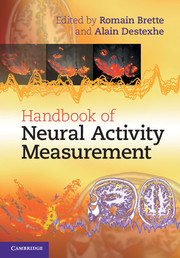Book contents
- Frontmatter
- Contents
- List of contributors
- 1 Introduction
- 2 Electrodes
- 3 Intracellular recording
- 4 Extracellular spikes and CSD
- 5 Local field potentials
- 6 EEG and MEG: forward modeling
- 7 MEG and EEG: source estimation
- 8 Intrinsic signal optical imaging
- 9 Voltage-sensitive dye imaging
- 10 Calcium imaging
- 11 Functional magnetic resonance imaging
- 12 Perspectives
- Plate section
- References
5 - Local field potentials
Published online by Cambridge University Press: 05 October 2012
- Frontmatter
- Contents
- List of contributors
- 1 Introduction
- 2 Electrodes
- 3 Intracellular recording
- 4 Extracellular spikes and CSD
- 5 Local field potentials
- 6 EEG and MEG: forward modeling
- 7 MEG and EEG: source estimation
- 8 Intrinsic signal optical imaging
- 9 Voltage-sensitive dye imaging
- 10 Calcium imaging
- 11 Functional magnetic resonance imaging
- 12 Perspectives
- Plate section
- References
Summary
Introduction
Extracellular electric potentials, such as local field potentials (LFPs) or the electroencephalogram (EEG), are routinely measured in electrophysiological experiments. LFPs are recorded using micrometer-size electrodes, and sample relatively localized populations of neurons, as these signals can be very different for electrodes separated by 1 mm (Destexhe et al., 1999a) or by a few hundred micrometers (Katzner et al., 2009). In contrast, the EEG is recorded from the surface of the scalp using millimeter-scale electrodes and samples much larger populations of neurons (Niedermeyer and Lopes da Silva, 1998). LFPs are subject to much less filtering compared to EEG, because EEG signals must propagate through various media, such as cerebrospinal fluid, dura mater, cranium, muscle and skin. LFP signals are also filtered, because the recording electrode is separated from the neuronal sources by portions of cortical tissue. Besides these differences, EEG and LFP signals display the same characteristics during wake and sleep states (Steriade, 2003).
The observation that action potentials have a limited participation in the genesis of the EEG or LFPs dates from early studies. Bremer (1938, 1949) was the first to propose that the EEG is not generated by action potentials, based on the mismatch of the time course of EEG waves with action potentials. Eccles (1951) proposed that LFP and EEG activities are generated by summated postsynaptic potentials arising from the synchronized excitation of cortical neurons. Intracellular recordings from cortical neurons later demonstrated a close correspondence between EEG/LFP activity and synaptic potentials (Klee et al., 1965; Creutzfeldt et al., 1966a, 1966b).
- Type
- Chapter
- Information
- Handbook of Neural Activity Measurement , pp. 136 - 191Publisher: Cambridge University PressPrint publication year: 2012
References
- 19
- Cited by



